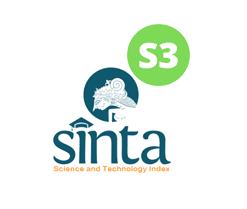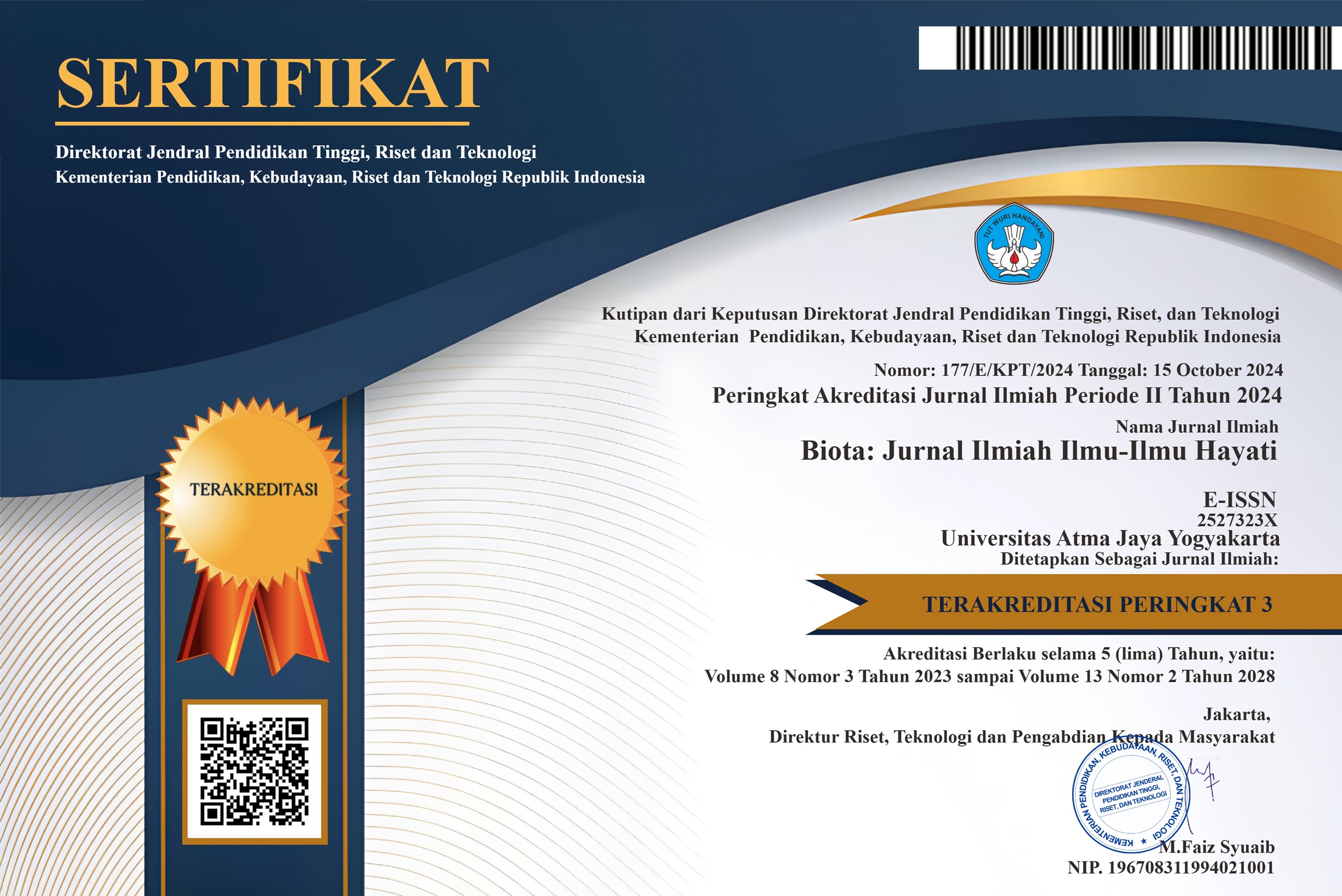Prediksi Asam Kuinat Sebagai Anti-Inflamasi Terhadap COX-2 Secara Virtual
DOI:
https://doi.org/10.24002/biota.v4i3.2516Keywords:
anti-inflamasi, asam amino, asam kuinat, cox-2, in silico, coffeeAbstract
Inflamasi merupakan mekanisme pertahanan tubuh terhadap terhadap rangsangan berbahaya, seperti patogen, sel-sel yang rusak, senyawa beracun, atau iradiasi. Selama inflamasi dalam tubuh terdapat COX-2 mediator inflamasi yang peran meningkatkan inflamasi. Sistem imun anti-inflamasi yang mengalami mutasi menyebabkan inflmasi meningkat. Oleh karena itu untuk menurnkannya menggunakan bioaktif alam. Asam kuinat memiliki toksisitas yang sangat rendah dan tidak memberikan efek negatif terhadap organ tubuh manusia. Asam kuinat memiliki potensi yang besar sebagai kandidat obat tertinggi dalam terapi. Akan tetapi kurangnya kajiannya. Penelitian ini bertujuan unutk memprediksi potensi serta menganalisis asam kuinat sebagai agen inflamasi dengan cara menghambat COX-2. Metode yang digunakan terdiri atas pengunduhan protein COX-2 dari protein data bank (PDB) dan asam kuinat diperoleh dari database PubChem, persiapan protein (COX-2) dan ligan (asam Kuinat) dengan program PyRx, analisis interaksi protein dan ligan menggunakan program Hex 8.0.0 dan Discovery Studio client 4. Interaksi antara protein dan ligan menunjukan hasil positif dengan ditemukan 2 domain protein yang berikatan dengan asam kuinat. Protein domain A (GLU140, ASN144, SER143, dan TRP139) dan protein domain B (GLU236, THR237, LYS333, GLN241, GLN330, PHE329, dan LEU238). Ikatan yang terbentuk ada ikatan hidrogen dengan energi sebesar -198.95cal/mol. Asam kuinat diprediksi memiliki potensi sebagai terapi anti-inflamasi, hal ini ditunjukan karena ada ikatan yang terbentuk antara ligan dan 11 residu asam amino.
References
Aziz, T. 2009. Pengaruh Pelarut Heksana Dan Etanol, Volume Pelarut, Dan Waktu Ekstraksi Terhadap Hasil Ekstraksi Minyak Kopi. 16(1), 8.
Bare, Y., & Fatchiyah, F. 2018. Profil Protein pada Organ Tikus (Rattus norvegicus) Model Diabetes Melitus Tipe 2 (DMT2). Biota, 11(1), 1–12. https://doi.org/10.20414/jb.v11i1.95
Bare, Y., Marhendra, A., Sasase, T., & Fatchiyah, F. 2018. Differential Expression of IL-10 Gene and Protein in Target Tissues of Rattus Norvegicus Strain Wistar Model Type 2 Diabetes Mellitus (T2DM). Acta Informatica Medica, 26(2), 87. https://doi.org/10.5455/aim.2018.26.87-92
Chaudhury, A., Duvoor, C., Reddy Dendi, V. S., Kraleti, S., Chada, A., Ravilla, R., … Mirza, W. 2017. Clinical Review of Antidiabetic Drugs: Implications for Type 2 Diabetes Mellitus Management. Frontiers in Endocrinology, 8. https://doi.org/10.3389/fendo.2017.00006
Chen, L., Deng, H., Cui, H., Fang, J., Zuo, Z., Deng, J., … Zhao, L. 2018. Inflammatory responses and inflammation-associated diseases in organs. Oncotarget, 9(6). https://doi.org/10.18632/oncotarget.23208
Coussens, L. M., & Werb, Z. 2002. Inflammation and cancer. Nature, 420(6917), 860–867. https://doi.org/10.1038/nature01322
Farhaty, N. (2016). Tinjauan Kimia Dan Aspek Farmakologi Senyawa Asam Klorogenat Pada Biji Kopi: Review. 14, 14. https://doi.org/10.24198/jf.v14i1.10769
Gao, Z., Zhang, H., Liu, J., Lau, C. W., Liu, P., Chen, Z. Y., … Huang, Y. 2014. Cyclooxygenase-2-dependent oxidative stress mediates palmitate-induced impairment of endothelium-dependent relaxations in mouse arteries. Biochemical Pharmacology, 91(4), 474–482. https://doi.org/10.1016/j.bcp.2014.08.009
Higdon, J. V., & Frei, B. 2006. Coffee and Health: A Review of Recent Human Research. Critical Reviews in Food Science and Nutrition, 46(2), 101–123. https://doi.org/10.1080/10408390500400009
Inbathamizh, L., & Padmini, E. 2013. QUINIC ACID AS A POTENT DRUG CANDIDATE FOR PROSTATE CANCER – A COMPARATIVE PHARMACOKINETIC APPROACH. 6(4), 7. https://doi.org/10.1111/cbdd.12498
Kawahara, K., Hohjoh, H., Inazumi, T., Tsuchiya, S., & Sugimoto, Y. 2015. Prostaglandin E2-induced inflammation: Relevance of prostaglandin e receptors. Biochimica et Biophysica Acta - Molecular and Cell Biology of Lipids, 1851(4), 414–421. https://doi.org/10.1016/j.bbalip.2014.07.008
Kellogg, A., Pop-Busui, R., & Cheng, H. T. 2008. Cyclooxygenase-2 Pathway as a Potential Therapeutic Target in Diabetic Peripheral Neuropathy. Current Drug Targets, 9(1), 68–76. https://doi.org/10.2174/138945008783431691
Kesuma, D., Siswandono, S., Purwanto, B. T., & Hardjono, S. 2018. Uji in silico Aktivitas Sitotoksik dan Toksisitas Senyawa Turunan N-(Benzoil)-N’- feniltiourea Sebagai Calon Obat Antikanker. JPSCR : Journal of Pharmaceutical Science and Clinical Research, 3(1), 1. https://doi.org/10.20961/jpscr.v3i1.16266
Libby, P. 2006. Inflammation and cardiovascular disease mechanisms. The American Journal of Clinical Nutrition, 83(2), 456S-460S. https://doi.org/10.1093/ajcn/83.2.456S
Libby, P. 2013. History of Discovery: Inflammation in Atherosclerosis. 15. https://doi.org/10.1161/ATVBAHA. 108.179705.
Lipinski, C. A., Lombardo, F., Dominy, B. W., & Feeney, F. J. 1997. Experimental and computational approaches to estimate solubility and permeability in drug discovery and development settings. Advanced Drug Delivery Reviews, 23, 3–25. https://doi.org/10.1016/S0169-409X(96)00423-1
Medzhitov, R. 2010. Inflammation 2010: New Adventures of an Old Flame. Cell, 140(6), 771–776. https://doi.org/10.1016/j.cell.2010.03.006
Radi, Z. A. 2012. Comparative Pathophysiology and Toxicology of Cyclooxygenases. In Comparative Pathophysiology and Toxicology of Cyclooxygenases. https://doi.org/10.1002/9781118351918
Regulski, M., Piotrowska-Kempisty, H., Prukała, W., Dutkiewicz, Z., Regulska, K., Stanisz, B., & Murias, M. 2018. Synthesis, in vitro and in silico evaluation of novel trans -stilbene analogues as potential COX-2 inhibitors. Bioorganic & Medicinal Chemistry, 26(1), 141–151. https://doi.org/10.1016/j.bmc.2017.11.027
Retailleau, K., Belin De Chantemèle, E. J., Chanoine, S., Guihot, A. L., Vessières, E., Toutain, B., … Henrion, D. 2010. Reactive oxygen species and cyclooxygenase 2-derived thromboxane A2 reduce angiotensin II type 2 receptor vasorelaxation in diabetic rat resistance arteries. Hypertension, 55(2), 339–344. https://doi.org/10.1161/HYPERTENSIONAHA.109.140236
Robertson, R. P., & Harmon, J. S. 2006. Diabetes, glucose toxicity, and oxidative stress: A case of double jeopardy for the pancreatic islet ?? Cell. Free Radical Biology and Medicine, 41(2), 177–184. https://doi.org/10.1016/j.freeradbiomed.2005.04.030
Santoso, B., & Atmajaya, T. E. 2016. KAJIAN DOCKING SENYAWA 4-[(Z)-N-(4-hidroksifenil)carboksimidoil]-2- metoksifenol SEBAGAI INHIBITOR COX-2 MENGGUNAKAN PLANTS. 8.
Schröter, D., Neugart, S., Schreiner, M., Grune, T., Rohn, S., & Ott, C. 2019. Amaranth’s 2-Caffeoylisocitric Acid—An Anti-Inflammatory Caffeic Acid Derivative That Impairs NF-κB Signaling in LPS-Challenged RAW 264.7 Macrophages. Nutrients, 11(3), 571. https://doi.org/10.3390/nu11030571
Shanmugam, N., Gonzalo, I. T. G., & Natarajan, R. 2004. Molecular Mechanisms of High Glucose-Induced Cyclooxygenase-2 Expression in Monocytes. Diabetes, 53(3), 795–802. https://doi.org/10.2337/diabetes.53.3.795
Shi, H., Dong, L., Jiang, J., Zhao, J., Zhao, G., Dang, X., … Jia, M. 2013. Chlorogenic acid reduces liver inflammation and fibrosis through inhibition of toll-like receptor 4 signaling pathway. Toxicology, 303, 107–114. https://doi.org/10.1016/j.tox.2012.10.025
Xie, Y., Kang, X., Ackerman, W. E., Belury, M. A., Koster, C., Rovin, B. H.,
Kniss, D. A. 2006. Differentiation-dependent regulation of the cyclooxygenase cascade during adipogenesis suggests a complex role for prostaglandins. Diabetes, Obesity and Metabolism, 8(1), 83–93. https://doi.org/10.1111/j.1463-1326.2005.00472.x
Yusianto, & Nugroho, D. 2014. Physical and Flavor Profiles of Arabica Coffee as Affected by Cherry Storage Before Pulping. Pelita Perkebunan (a Coffee and Cocoa Research Journal), 30(2), 137–158. https://doi.org/10.22302/iccri.jur.pelitaperkebunan.v30i2.7
Zhang, C., Maddelein, M.-L., Wai-Yin Sun, R., Gornitzka, H., Cuvillier, O., & Hemmert, C. 2018. Pharmacomodulation on Gold-NHC complexes for anticancer applications – is lipophilicity the key point? European Journal of Medicinal Chemistry, 157, 320–332. https://doi.org/10.1016/j.ejmech.2018.07.070
Downloads
Published
How to Cite
Issue
Section
License
Copyright (c) 2019 Yohanes Bare, Agustina Dua Kuki, Apriani Herni Rophi, Gabriella Candrakirana Krisnamurti, Margaretha Rika Wahyu Gabrella Lorenza, Dewi Ratih Tirto Sari

This work is licensed under a Creative Commons Attribution-NonCommercial 4.0 International License.
Authors who publish with Biota : Jurnal Ilmiah Ilmu-Ilmu Hayati agree to the following terms:
- Authors retain copyright and grant the Biota : Jurnal Ilmiah Ilmu-Ilmu Hayati right of first publication. Licensed under a Creative Commons Attribution-NonCommercial 4.0 International License that allows others to share the work with an acknowledgment of the work's authorship and initial publication in this journal.
- Authors are able to enter into separate, additional contractual arrangements for the non-exclusive distribution of the journal's published version of the work (e.g., post it to an institutional repository or publish it in a book), with an acknowledgment of its initial publication in Biota : Jurnal Ilmiah Ilmu-Ilmu Hayati, and as long as Author is not used for commercial purposes.













